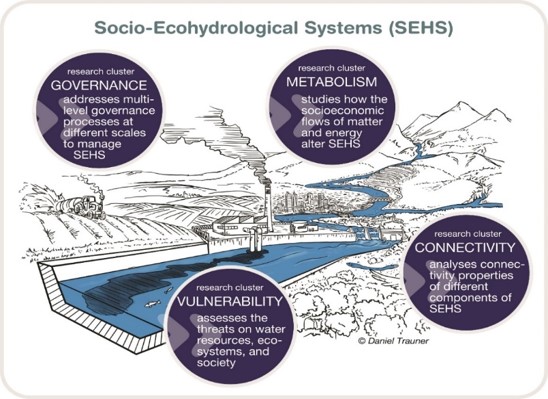Description of the conceptual approach and the three research fields
Description of the conceptual approach and the three research fields
HR21 scientific framework
Our approach is based on the distinction between natural (eco-hydrological) and social (socio-cultural-economic) systems, which we see as co-evolving SEHS. The study of SEHS requires the expertise from three research domains: i.e. natural sciences, engineering, and the social sciences and humanities along with their integration and synthesis, embedded in four research clusters (RC). Transformation processes in IRL are the result of coupled natural and social processes in river systems. Hence, understanding this coupling of eco-hydrological with social systems including relevant actors and institutions through the concepts of metabolism and colonization as defined in Social Ecology is the foundation of our interdisciplinary research.
Our framework is structured into four RC: (i) Connectivity, addressing social, ecological, hydrological, and landscape spatial properties of IRL, (ii) Governance and planning addressing mainly how social systems interact with IRL, iii) Metabolism of social and natural systems, addressing how societal flows of matter and energy interact with ecohydrological systems as sources and sinks, and iv) Vulnerability to impacts, risks, and shifting baselines essentially influencing how ecohydrological and social systems co-evolve in SEHS.


Research Fields Industrialized riverine landscapes
Extreme events
IRLs are complex systems shaped by the hydrological cycle and altered by human interventions. To understand the coupling of social with natural systems in IRLs, extreme events are of particular importance [Field]. They pose manifold threats and disturbances to ecosystems and societies, causing inundation of settlements, infrastructure or agricultural land, but also lead to a deterioration of water quality or lack of water resources for ecosystems and society. The magnitude and frequency of hydrometeorological extremes is expected to increase regionally due to global change of hydrological, biogeochemical, and biological dynamics in river systems. These processes are challenging the integrity and functioning of ecosystems, thereby restricting the provision of ecosystem services for society. These restrictions can also lead to long-term natural and societal transformation processes. Therefore, determining short- and long-term changes in connectivity and water transit times is of importance, not only for assessing hydrological aspects but also the transport of pollutants affecting water quality.
Urbanization and infrastructure
The current pronounced global trend of urbanization is one of the most important drivers of global environmental change. It has significantly contributed to the development of IRL via the built environment. We find more and more residential, commercial, and industrial areas, roads, bridges, and other transport facilities in (former) floodplains. The river itself has become a waterway with ports; facilities for water supply, wastewater treatment and disposal divert and convert the flow of water and impact water quality. Energy is directly produced via hydropower or indirectly via the water-cooling of caloric nuclear power plants or other industrial facilities, and also affecting IRL via a grid of crossing power lines. Additionaly, flood protection, settlements, irrigation, and drainage for agriculture interact with the aquatic ecosystems. In all these infrastructures, the historical process of industrialization has manifested itself.
Water-energy-food-nexus (WEF)
The water-energy-food nexus (WEF) is central to the sustainable transformation of IRL and their ecosystem perspective given the increasing resource demand of a growing population and further environmental and economic aspects of water, food, and energy security. In the context of SEHS, the WEF provides “cross-sectoral and dynamic perspective” and deals with the complex, often conflicting interrelations of water, energy and land resources, which exert multiple stressors on IRLs, mainly related to water quality and quantity and biodiversity, increasing agricultural and forest production, urbanization, recreational use, and energy generation both within the aquatic system (hydropower) and in the catchment (e.g., wind and solar energy, biofuel crops). Applying the concept of SEHS, our approach connects WEF nexus research with research questions specific for IRL. As the WEF integrates water and land management as well as governance approaches across sectors and scales, it aims, inter alia, at higher resource efficiency, the reduction of trade-offs and an increase in synergies for more policy coherence.
